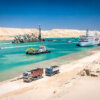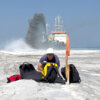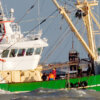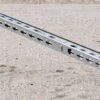Contractual monitoring during the project is monitoring as stipulated in the dredging contract and may even be included in the conditions of permitting.
Monitoring during the contract
Monitoring during the works is quite often stipulated in the dredging contract or as a condition of the permitting. Monitoring may take the form of:
- Bathymetric surveying, both at the borrow (excavation) site and the placement (reclamation) site, to check that dredging and placement are being effectively controlled.
- Suspended sediment monitoring may also be required to ensure that plumes of suspended sediment arising from the dredging or placement works are acceptable.
Pre-project assessment
A pre-project assessment of the characteristics of the materials to be dredged and the likely placement sites is always necessary. Such materials characterisations help the parties to:
- better define the placement options;
- estimate the quantities of materials to be suitably placed in each of the options;
- decide about the dredging equipment to be used, considering not only the placement requirements, but also considering the transportation of material to the placement options;
- minimise sediment re-suspension and loss during dredging;
- establish monitoring programmes at both dredging and placement sites; and
- implement mitigation measures that may be required at the dredging or placement sites.
Ongoing environmental monitoring of the dredging and placement sites is likely to be a contractual requirement either under permit regulations or to be consistent with international conventions.
Post-construction monitoring
Post-construction monitoring of placement sites, both open water and upland, are also essential to determining if the mitigation measures are adequate to prevent serious environmental harm. This is particularly true where contaminated dredged materials are involved.
Such monitoring is also useful in establishing a database for future work in the area where either more or less stringent controls may be appropriate.
It should be noted that monitoring periods may need to be prolonged to enable adequate data sets to be obtained.
”Background” monitoring on site
To carry out dredging works in an environmentally acceptable manner it may be necessary to control the works in such a way that environmental disturbance is reduced to the lowest possible level. Often this level is related to background levels of environmental parameters measured on site. This in itself may lead to complications that take some considerable time to resolve.
Many maritime sites are situated in dynamic regions of a coast, in estuaries or rivers. The background conditions at these sites vary continuously from minute to minute and hour to hour, depending on:
- tidal and river flow,
- wave activity,
- rainfall,
- disturbances caused by other natural and human events (such as the passage of vessels), and
natural variations as a result of seasonal changes in sunlight, temperature and biological activity.
Thus to define what is meant by “background” is no easy matter, even if all the environmental parameters are measured and analysed.
Measurement of parameters
Measurements of parameters include amongst other things:
- current speeds,
- temperature,
- salinity,
- dissolved oxygen and
- suspended sediment levels.
These are usually carried out over considerable periods of time before all the underlying patterns are identified. For a major port development or land reclamation, a period of two years or longer might be considered quite normal. It is, therefore, important to commence monitoring at a very early stage of project development, even if the initial monitoring campaigns are restricted to determining which parameters are relevant and their variability.
In many navigable waters the disturbance of the seabed caused by deep- draught vessels is of a higher level and frequency than that caused by dredging operations.

















